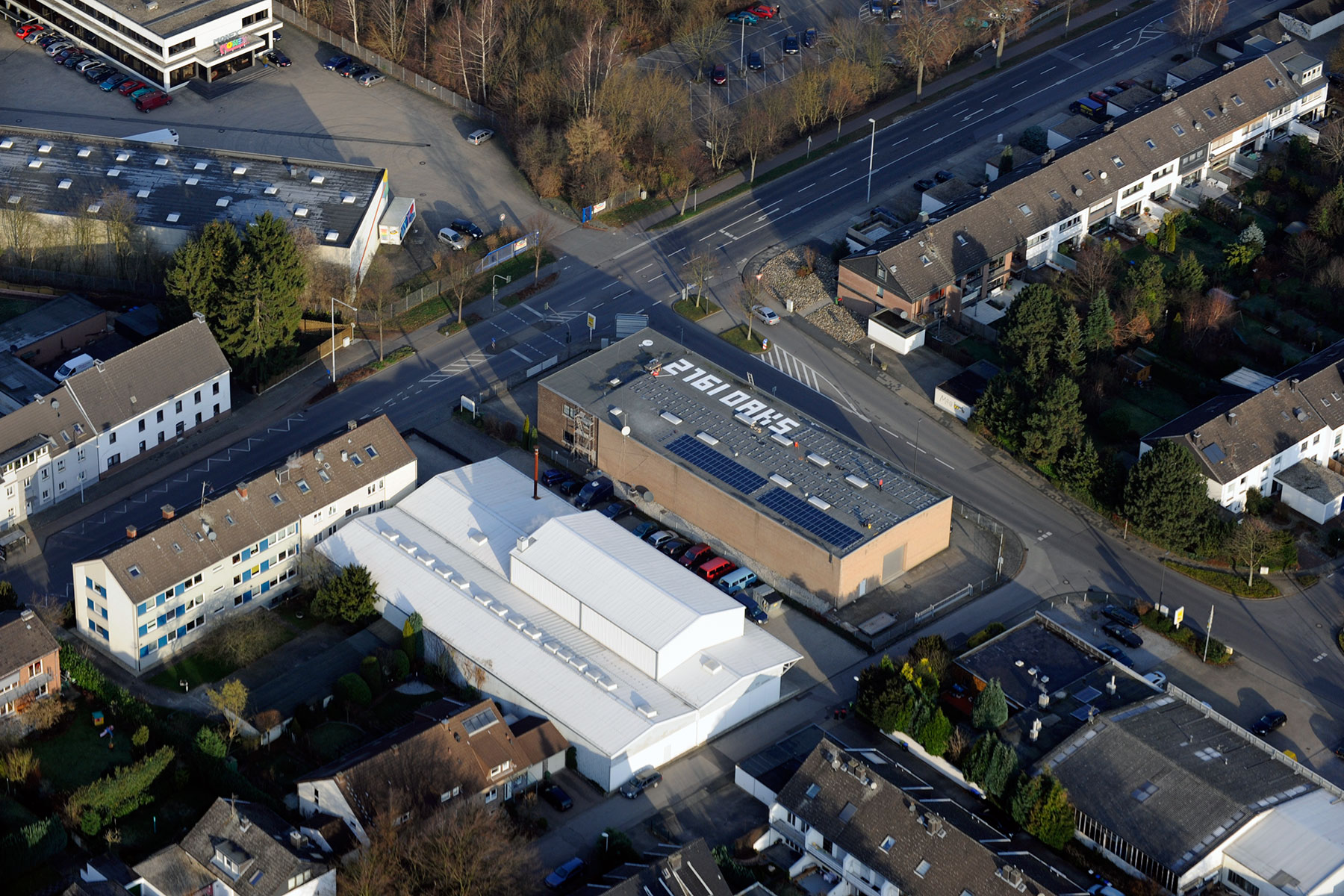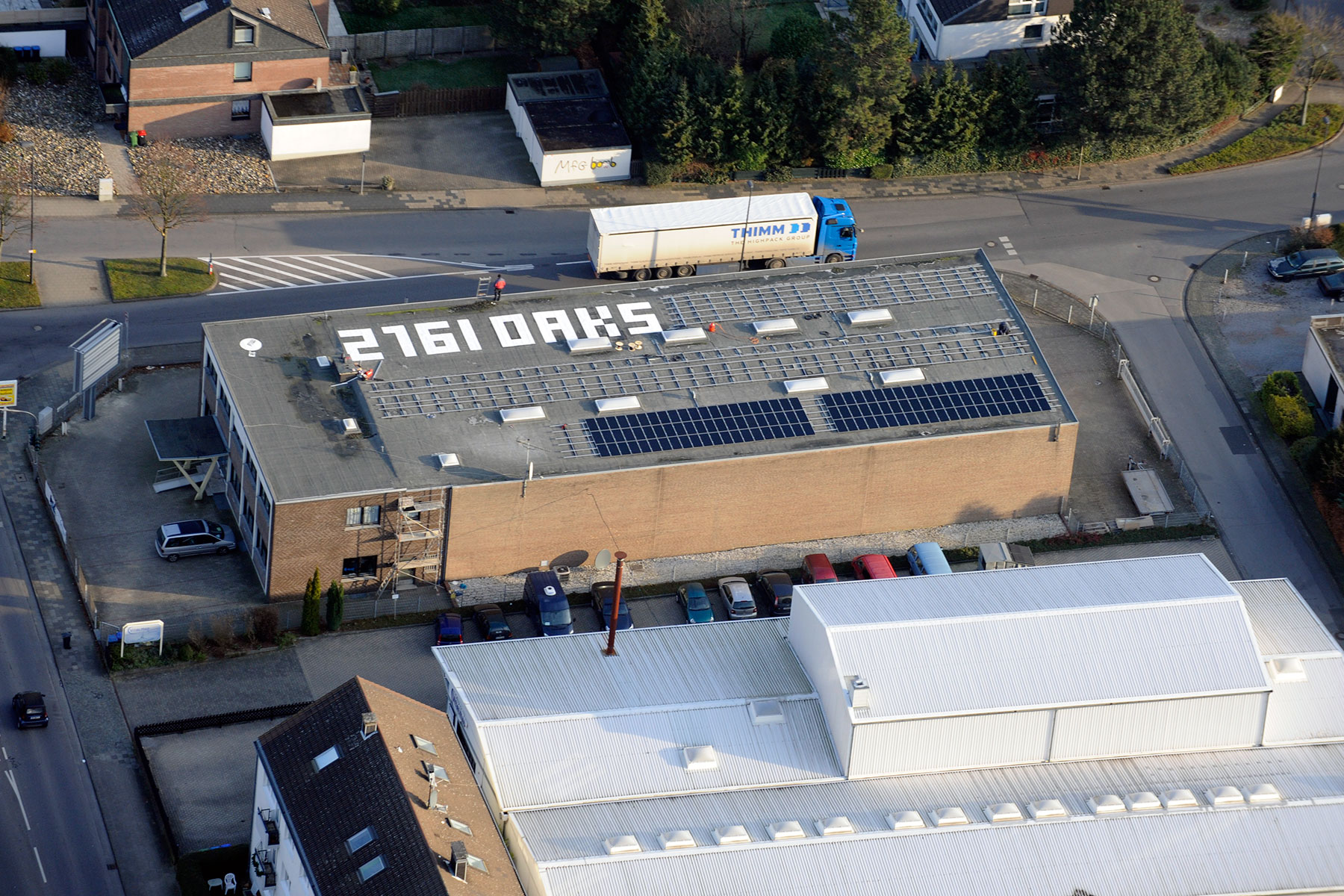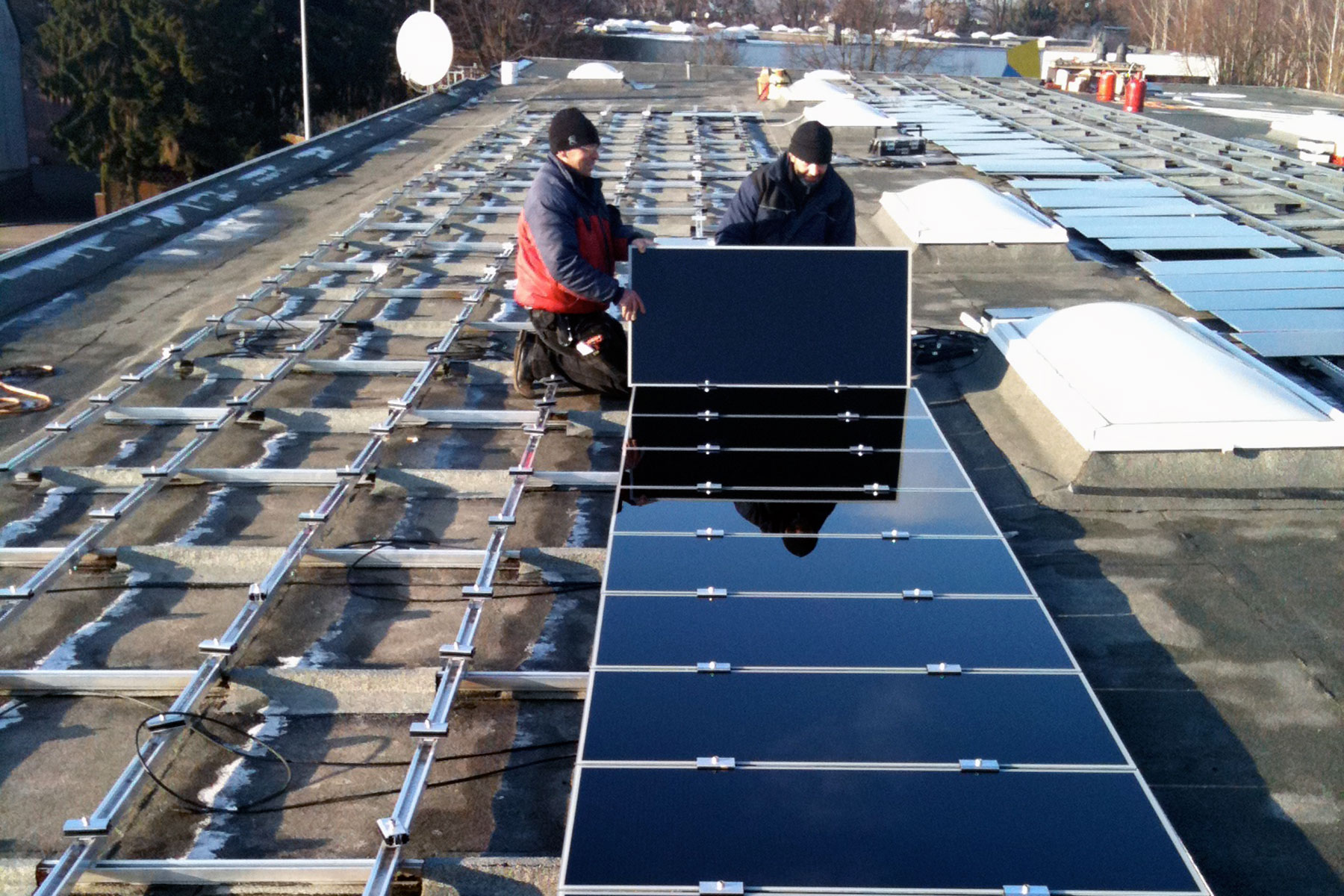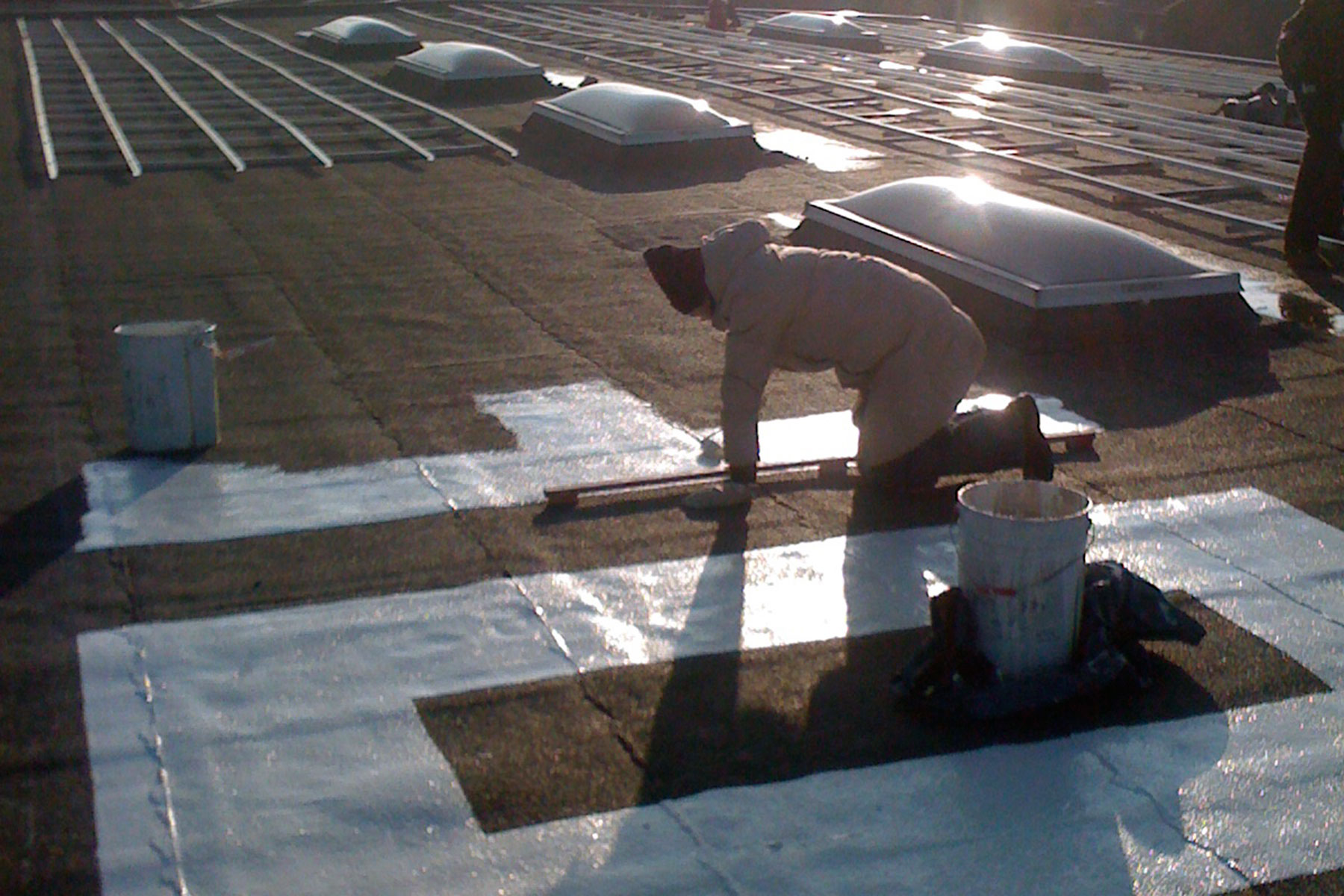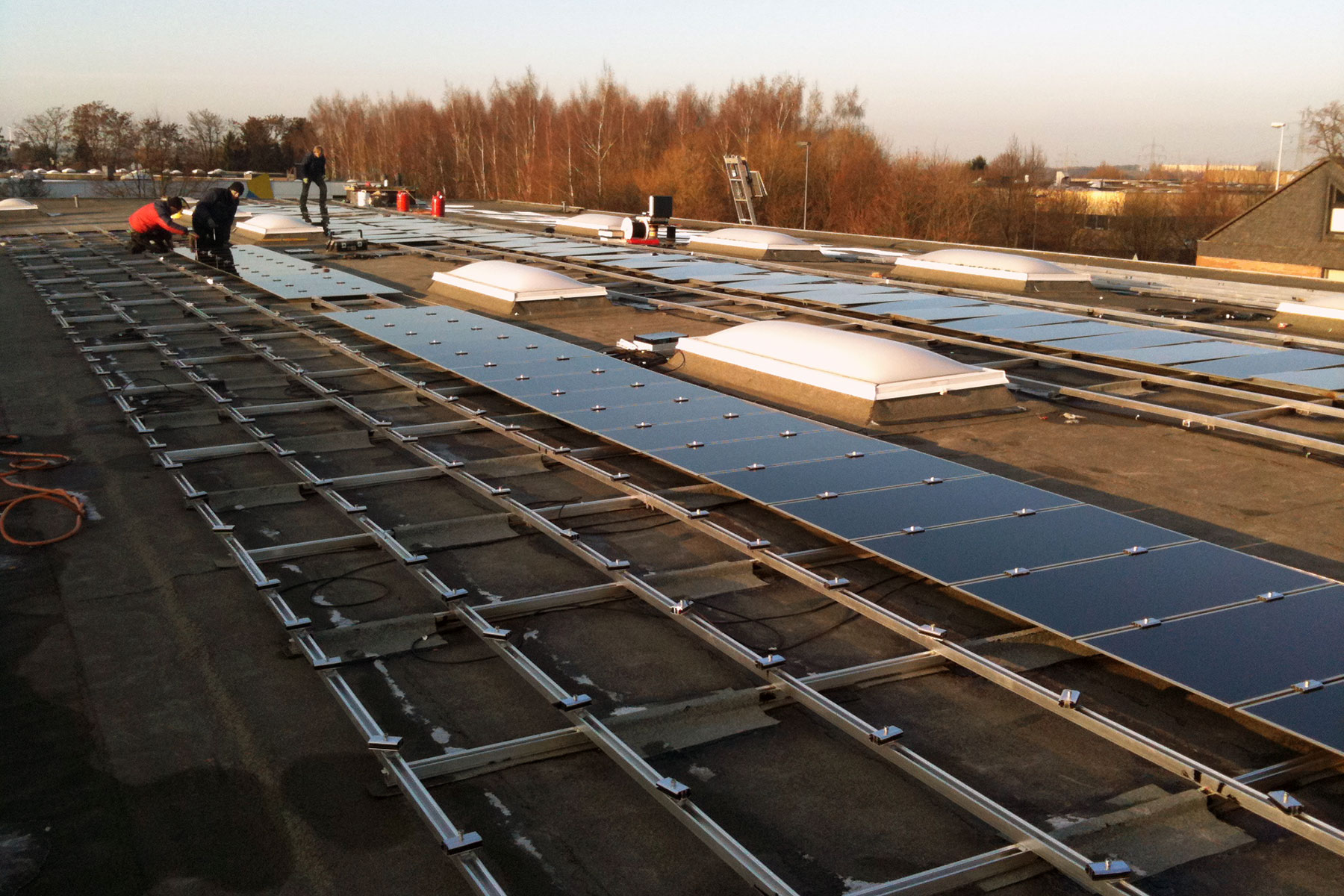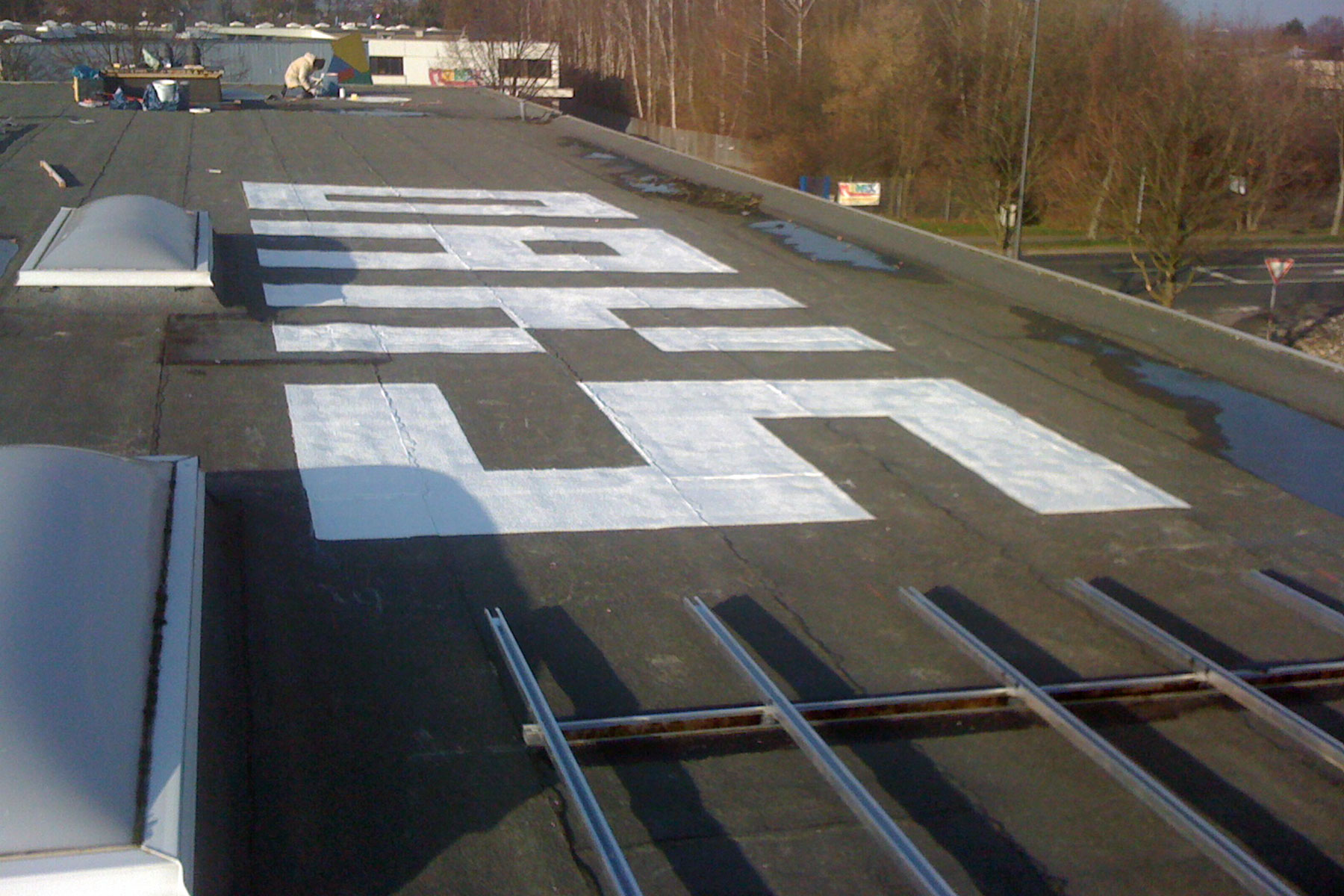Parallel to switching on a 30 KW photovoltaic system on a warehouse in Aachen, the words 2671 OAKS were written on its roof. The message reveals the exact number of oaks that are spared by the potential carbon dioxide not emitted by this photovoltaic system. A tribute to the “7000 Oaks” action by Joseph Beuys.
Installed | Location | GPS: 17-12-2009 | Warehouse, Aachen, Germany | 50.81383,6.06311
Author | Words: REMOTEWORDS| 2761 OAKS
Roof Size | Font Size: 800qm | 5m x 18,85m
On Air: –
Interview
REMOTEWORDS, KoeLN 2009
As a contribution to the world climate summit, Remotewords — parallel to switching on a 30.000 W photovoltaic system — will write “2761 OAKS” on the roof of a warehouse in Aachen. The message refers to Joseph Beuys’ action of “7000 Oaks” and cites the precise number of trees that correspond to the potential amount of carbon dioxide that the photovoltaic system will not emit. The 500-square-meter facility compensates for a 18400-sq.-meter oak forest.
RW: The words “2761 Oaks” are found next to a photovoltaic facility. What is that supposed to mean?
RW: Switching on the photovoltaic system was this building’s defining moment and when we thought about the message this sent out, we remembered the Land Art action by Joseph Beuys. Between documenta 7 and 8, Joseph Beuys had 7000 oaks planted in tubs.
RW: What do solar panels have to do with German oaks?
RW: This photovoltaic system will generate a fair amount of electricity: It will generate 24,000 kilowatts annually or 600 million watts of electricity over a 25-year period. In this way the facility will compensate for a huge amount of CO2 emissions. And that is exactly what Joseph Beuys did by planting oak trees in the 1980s.
RW: But oaks are not solar modules!
RW: NO, but here on the roof where nature cannot find a hold, technology must do the trick. Which is sensible, for in this case technology replaces nature very effectively. As the experts from Co2ol.de have calculated, this facility will save us 12,707 tons of CO2 emissions per year. That already represents the energy spent for so-called preproduction, which is the energy needed for the construction, the silicon, the transportation. It is subtracted from the 14,352 tons that the facility annually compensates for. Thus we arrive at the 12,707 tons of absolute CO2 not emitted in comparison to the conventional production of electricity in Germany. And that, for instance, compensates for driving a compact car 75,000 kilometers or 1,875 million kilometers over its running time. What especially fascinates us is the following picture: One hectare, that is, 10,000 sq.m. of oak forest, in its first 20 years on average absorbs approx. 6.9 t CO2 (Source: Carbon sequestration of young reforested areas, Technical University of Munich, 2009). Since an oak forest gains in wood pulp over the years, CO2 storage can double the amount from year 20 and can even go as high as 20tCO2/ha. Around 1500 oaks are planted per hectare, so that one oak during its first 20 years of growth binds approx. 4.6 kg CO2 per year. Dividing the 12,703 tons of non-emitted CO2 by 4.6 kg per oak gives us 2761. The PV facility thus corresponds to an equivalent of 2761 oaks from the age of 1 to 20. Or put another way: the 500 sq.m. facility compensates for an oak forest of 18400 sq.m.
RW: And yet most people prefer a genuine oak forest.
RW: Certainly, but technology here works 37 times more effectively in sparing us CO2 emissions than nature in the form of reforestation could on the same amount of space. Land is becoming every scarcer and its use must be ever more carefully calculated and more effectively utilized. Our future entails linking technology and nature in a sensible way. The roof is anyway lost to oak woods, but wonderfully suitable for CO2 compensation by technical means, which in turn benefits nature.
RW: But expensive, isn’t it? Not everyone can afford a PV system.
RW: But they can! Anyone can get credit, since the KFW Bank (reconstruction loan corporation) has the expensive facility as security, and other financial backgrounds don’t have to be provided. In the Allgäu you can see giant areas of PV panels on the stables of milk farmers; there are facilities worth up to a million Euro. If you have a roof available, you can buy shares in a large PV facility. That is far better than “investing” in RWE, EON, Vattenfall and all the other companies. These are still putting obstacles in the way of decentralized power supplies, recently through the completely counterproductive prolongation of the running time of atomic plants.
RW: What will the uninitiated Google Earth users think when they read “1234 Oaks”?
RW: It’s hard to say, perhaps of Magritte? “Ceci n’est pas un pipe.” Solar modules are not oaks, but both fulfill a common and very urgent mission, absorbing CO2. They do so quite differently, but each in its own way as if by magic and sorcery.
Als Beitrag zum Weltklimagipfel schreibt REMOTEWORDS parallel zur Inbetriebnahme einer 30 KW Photovoltaikanlage „2761 OAKS“ auf ein Aachener Lagerhallendach. Die Nachricht bezieht sich auf Josef Beuys Aktion „7000 Eichen“ und bezeichnet exakt die Anzahl der Eichen, die dem Kohlendioxideinsparpotential der Photovoltaikanlage entsprechen. Die 500 Quadratmeter große Anlage kompensiert das Adäquat von 25000 Quadratmeter Eichenwald.
RW: Neben einer Photovoltaik Anlage finden sich die Worte „2761Eichen“. Was hat das zu bedeuten?
RW: Die Inbetriebnahme der Photovoltaikanlage war das bestimmende Moment für dieses Gebäude und als wir über die Nachricht dazu nachdachten, haben wir uns an die Land Art Aktion von Josef Beuys erinnert. Zwischen der Dokumenta 7 und 8 hat Josef Beuys 7000 Eichen in Kassel pflanzen lassen.
RW: Was hat Photovoltaik mit deutschen Eichen zu tun?
Diese Photovoltaikanlage wird eine schöne Menge Strom erzeugen: jährlich 24.000 Kilowatt oder 600 Millionen Watt Strom in 25 Jahren Laufzeit. Somit kompensiert die Anlage eine große Menge CO2- Ausstoß. Und eben genau das hat Josef Beuys auch durch das Pflanzen der Eichen in den 80 Jahren getan.
RW: Aber Eichen sind keine Solarmodule?
RW: Nein, aber hier auf dem Dach, wo keine Natur angesiedelt werden kann darf die Technik ran. Das ist sinnvoll, denn die Technik ersetzt die Natur in diesem Fall äußerst effektiv. Wie uns die Experten von Co2ol.de errechnet haben, wird diese Anlage pro Jahr 12,703 t CO2einsparen. Dies beinhaltet schon die aufgewendete Energie für die sogenannte Vorproduktion, also die Energie für die Herstellung, das Silizium, den Transport. Sie wird von den 14,352 Tonnen, die Anlage jährlich kompensiert, abgezogen. So kommen wir auf die 12,703 Tonnen absoluter CO2-Einsparung gegenüber der Herstellung konventionellen Stromes in Deutschland. Das gleicht beispielsweise 75.000 Kilometer Fahrt mit dem Kleinwagen pro Jahr oder 1,875 Millionen Kilometer in der Laufzeit aus. Was uns besonders fasziniert ist folgendes Bild:
Ein Hektar, also 10.000 qm Eichenwald bindet in den ersten 20 Jahren im Schnitt rund 6,9 t CO2 (Quelle: Paul, Weber, Mosandl: Kohlenstoffbindung junger Aufforstungsflächen, Technische Universität München 2009). Da ein Eichenwald erst mit den Jahren an Holzmasse zulegt ist die CO2 Speicherung ab dem Jahr 20 doppelt so hoch anzusetzen und kann sogar bis zu 20tCO2/ha*a annehmen. Für einen Hektar werden ca. 1500 Eichen gepflanzt, Somit bindet eine Eiche in den ersten 20 Wachstumsjahren im Schnitt rund 4,6 kg CO2 pro Jahr. Teilt man die 12,703 Tonnen CO2 Einsparung durch 4,6 kg pro Eiche ergeben sich 2761 Eichen. Die PV Anlage entspricht also dem Äquivalent von 2761 Eichen im Alter 1-20 Jahren. Oder anders gesagt: Die 500 Quadratmeter Anlage kompensiert das Adequat von 18400 Quadratmeter Eichenwald.
RW: Trotzdem sind den meisten Leuten die echten Eichenwälder lieber.
RW: Sicher, aber durch die Technik wird hier an der CO2-Kompensation 37 mal effektiver gearbeitet, als dies durch die Natur, in diesem Fall durch Aufforstung, bei gleichem Platzangebot, möglich wäre. Das Land wird immer knapper und sein Gebrauch muss immer sorgfälliger bedacht und effektiver genutzt werden. Unsere Zukunft besteht darin, Technik und Natur sinnvoll zu verbinden. Das Dach ist für Eichenwälder sowieso verloren, aber wunderbar geeignet zur CO2 Kompensation durch technische Mittel, welche der Natur ja wiederum zu gute kommen.
RW: Aber teuer, oder ? Eine PV Anlage kann sich nicht jeder leisten.
RW: Doch! Den Kredit erhält jedermann, da die KFW Bank die teure Anlage ja als Sicherheit hat und somit andere finanzielle Backgrounds nicht gegeben sein müssen. Im Allgäu sieht man bei den Milchbauern riesige PV-Flächen auf den Ställen, da stehen Anlagen im Wert von bis zu einer Millionen Euro. Wenn man kein Dach zur Verfügung hat, kann man sich Anteile an PV-Großanlagen kaufen. Das ist weit besser als in RWE, EON, Vattenfall und all die anderen Konzerne zu „investieren“. Sie legen einer dezentralen Stromversorgung immer noch Steine in den Weg, zuletzt durch die völlig kontraproduktive Laufzeitverlängerung der AKWs.
RW: Was wird der unvorbereitete Google Earth User denken, wenn der „1234 Oaks“ sieht?
RW: Schwer zu sagen, vielleicht an Magritte? „Ceci n’est pas un pipe“. Solarmodule sind keine Eichen, aber beide erfüllen eine gemeinsame, sehr dringende Aufgabe, die CO2 Bindung. Dies tun sie auf zwar ziemlich unterschiedliche Art, aber beide auf ihre Weise magisch und zauberhaft.


